Diaries from British soldiers serving on the frontline during World War I have been placed online by the National Archives.
Events from the outbreak of war in 1914 to the departure of troops from Flanders and France were recorded in official diaries of each military unit.
About 1.5 million diary pages are held by the National Archives and a fifth have been digitised so far.
The project is part of the government's World War One centenary programme.
Each British unit in World War One was required to keep a diary of its day-to-day activities.
WW1 soldier diaries placed online by National Archives
BBC News
14 January 2014
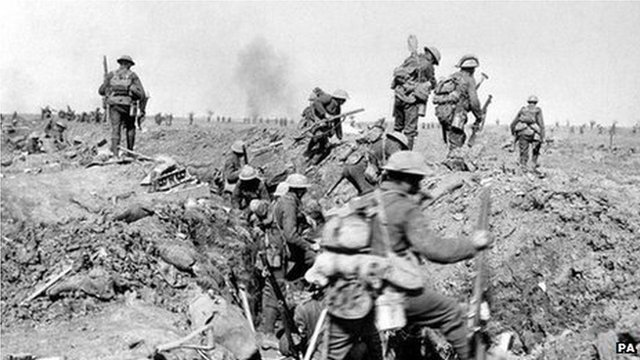
This year marks the 100th anniversary of the start of World War One
Diaries from British soldiers describing life on the frontline during World War One are being published online by the National Archives.
Events from the outbreak of war in 1914 to the departure of troops from Flanders and France were recorded in official diaries of each military unit.
About 1.5 million diary pages are held by the National Archives and a fifth have been digitised so far.
The project is part of the government's World War One centenary programme.
Each unit in World War One was required to keep a diary of its day-to-day activities.
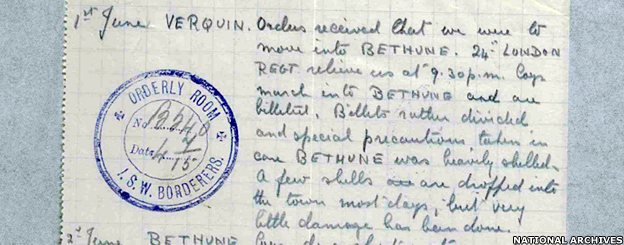
The first batch of 1,944 digitised diaries detail the experiences of three cavalry and seven infantry divisions in the initial wave of British army troops deployed in 1914.
Diaries from soldiers in the First Battalion South Wales Borderers portray the anxiety and terror of the opening days of the war in the battles of Marne and the Aisne.
They also reveal accounts of tug of war, rugby matches and farewell dinners to mark the end of the fighting.
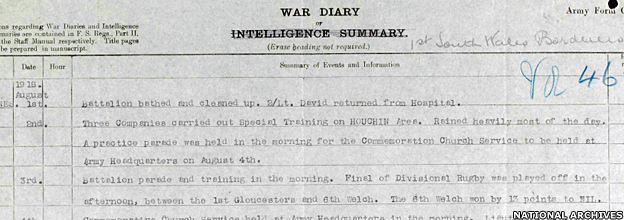
A private war diary kept by one of the First Battalion's soldiers, Captain James Paterson, has also been digitised.
Captain Paterson died on 1 November, some six weeks after an entry said the scenes he witnessed were "beyond description".
"Trenches, bits of equipment, clothing (probably blood-stained), ammunition, tools, caps, etc, etc, everywhere. Poor fellows shot dead are lying in all directions. Some of ours," he said.
"Everywhere the same hard, grim, pitiless sign of battle and war. I have had a belly full of it."

The private war diary of Captain James Paterson describes dead bodies "in all directions"
Other entries record the experiences of the 4th Dragoon Guards who fought in the Battle of Mons, the first major action of the war for the British Expeditionary Force in August 1914.
There are also diaries from soldiers of the 5th (Royal Irish) Lancers who saw action continuously between 1914 and 1918 and who included the last British soldier to die in the conflict, Private George Edwin Ellison, who was shot dead on 11 November 1918.
Some 25 volunteers scanned hundreds of boxes of diaries - which had been available for the public to view at the National Archive in Kew since the late 1960s - between January and December last year.
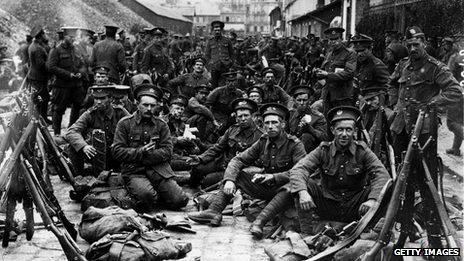
William Spencer, author and military records specialist at The National Archives, said it "creates opportunities for the public, history enthusiasts, family historians and researchers worldwide to explore the official records which may lead to some new discoveries and perspectives on this important period of history".
The National Archives, the Imperial War Museum and online research website Zooniverse are also launching Operation War Diary, a project aiming to encourage volunteers to uncover details from within the diaries.
Luke Smith, from the Imperial War Museum, said information that may not have previously been communicated through letters home or covered in traditional history books may be contained in the diaries.
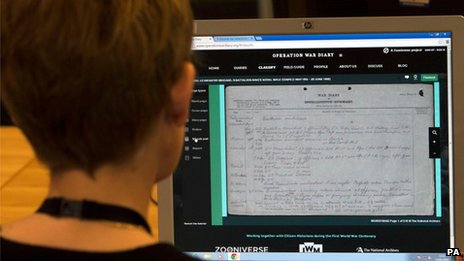
Volunteers are being encouraged to uncover new details about WW1
The volunteers to the project will be given a segment of a unit war diary and asked to tag key details such as names, places and events.
The data will be used in the National Archives' catalogue descriptions for the diaries, making it easier for people to trace their army ancestors.
Culture Secretary Maria Miller said: "The National Archives' digitised First World War unit diaries will allow us to hear the voices of those that sacrificed their lives and is even more poignant now there are no living veterans who can speak directly about the events of the war."
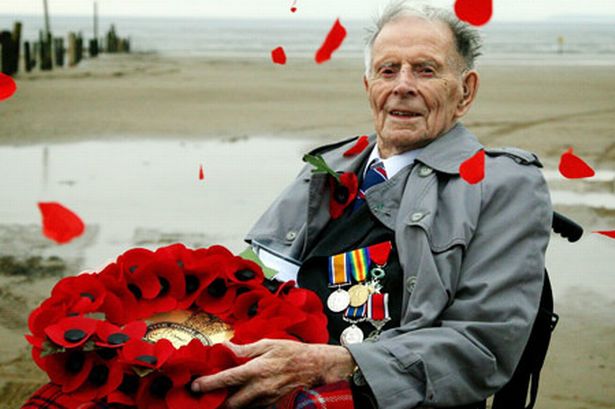
Harry Patch was Britain's, and the world's, last surviving soldier to have fought actually in the trenches of World War I. He died on 25th July 2009 aged 111 years, 1 month, 1 week and 1 day
Harry Patch, the last British survivor of the World War One trenches, died in 2009 aged 111.
The world's last known combat veteran of World War One, Claude Choules, died in Australia aged 110 in 2011.
THE ORIGINS OF WWI
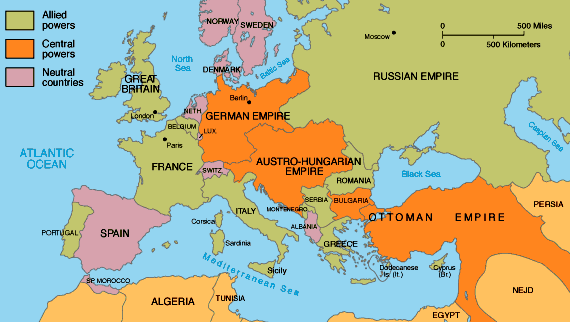
In Blackadder Goes Forth, Baldrick opined that the war began when 'Archie Duke shot an ostrich because he was hungry'. His garbled version of the assassination of Archduke Franz Ferdinand of Austria-Hungary reflects popular opinion: that the issues were not worth the ensuing bloodbath. Most modern scholars would NOT agree. Germany and Austria-Hungary (the Central Powers) are seen, at the very least, as creating the conditions for conflict. Some go much further, blaming Germany for planning and waging a deliberate war of aggression.
Under Kaiser Wilhelm II, Germany moved from a policy of maintaining the status quo to a more aggressive stance. He decided against renewing a treaty with Russia, effectively opting for the Austrian alliance. Germany's western and eastern neighbours, France and Russia, signed an alliance in 1894 united by fear and resentment of Berlin. In 1898, Germany began to build up its navy, although this could only alarm the world's most powerful maritime nation, Britain. Recognising a major threat to her security, Britain abandoned the policy of holding aloof from entanglements with continental European powers. Within ten years, Britain had concluded agreements, albeit limited, with her two major colonial rivals, France and Russia. Europe was divided into two armed camps: the Entente Powers and the Central Powers, and their populations began to see war not merely as inevitable but even welcome.
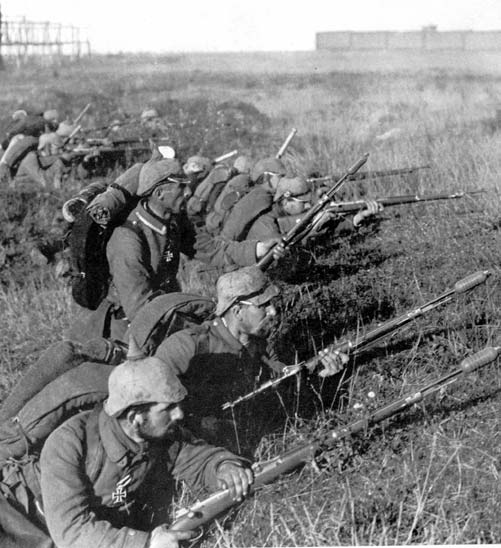
German soldiers during the First Battle of the Marne, 1914, in which they were defeated by the French and British. The First Battle of the Marne marked the end of the German sweep into France and the beginning of the trench warfare that was to characterise World War One
In the summer of 1914 the Germans were prepared, at the very least, to run the risk of causing a large-scale war. The crumbling Austro-Hungarian Empire decided, after the assassination on 28 June, to take action against Serbia, which was suspected of being behind the murder. The German government issued the so-called 'blank cheque' on 5-6 July, offering unconditional support to the Austrians, despite the risk of war with Russia. Germany, painted into a diplomatic corner by Wilhelm's bellicosity, saw this as a way of breaking up the Entente, for France and Britain might refuse to support Russia. Moreover, a wish to unite the nation behind the government may have been a motive. So might desire to strike against Russia before it had finished rebuilding its military strength after its defeat by Japan in 1905.
The most sinister interpretation is that Germany had been actively planning an aggressive war. In December 1912 the Kaiser held a meeting at which some historians believe it was decided to go to war some 18 months hence. This interpretation is controversial, but the bellicosity of Wilhelm and some senior advisors is clear, and the coincidence with the actual outbreak of war in August 1914 is remarkable.

British machine gunners. Most historians do not agree with the view that is often peddled that the conflict was not worth the bloodbath
A month after the war began, Germany drew up some far-reaching war aims. French power would be broken, Belgium reduced to vassal status (it was Germany's invasion of Belgium which led to the British declaring war on Germany), and a colonial empire carved out in Africa and elsewhere. Mitteleuropa, a German-dominated customs union, would give Berlin economic hegemony. As the war went on, Germany's appetite grew. In 1917-18 Germany set up a huge informal empire on the ruins of defeated Russia. There were distinct continuities with Hitler's aims in World War Two.
It is unclear whether Germany went to war to achieve these aims, or whether, having found themselves at war, they began to think about what they would do with the victory they hoped to win. Some important figures in Germany, including industrialists, politicians, and the Kaiser himself, favoured a radical approach. In 1914 fate seemed to have offered Germany the opportunity to turn dreams into imperial reality. Germany now controlled most of Belgium and some economically important parts of northern France. Campaigns in 1915-17 conquered Poland and portions of Russia. By the end of the war, the Germans were even casting covetous eyes on their ally, Austria-Hungary.

British soldiers who fell covering the retreat of the 5th Army, 1918. Described as the war to end all wars, World War I cost the British Empire around 1 million dead (995,939 of them British) and over 2 million wounded
The size and wealth of the conquered Eastern territories easily outweighed what would have been lost had the Germans withdrawn from Belgium and France. Had they done so, France might have made peace and the anti-German coalition collapsed. Instead, in March 1918, the German army struck on the Western Front in an attempt to knock Britain and France out of the war. The gamble failed and the Germans were themselves defeated by the Western Allies. Having played for everything, the German leadership lost everything.

The British introduced a deadly new weapon during the conflict - the tank
BBC News - WW1 soldier diaries placed online by National Archives
Events from the outbreak of war in 1914 to the departure of troops from Flanders and France were recorded in official diaries of each military unit.
About 1.5 million diary pages are held by the National Archives and a fifth have been digitised so far.
The project is part of the government's World War One centenary programme.
Each British unit in World War One was required to keep a diary of its day-to-day activities.
WW1 soldier diaries placed online by National Archives
BBC News
14 January 2014

This year marks the 100th anniversary of the start of World War One
Diaries from British soldiers describing life on the frontline during World War One are being published online by the National Archives.
Events from the outbreak of war in 1914 to the departure of troops from Flanders and France were recorded in official diaries of each military unit.
About 1.5 million diary pages are held by the National Archives and a fifth have been digitised so far.
The project is part of the government's World War One centenary programme.
Each unit in World War One was required to keep a diary of its day-to-day activities.

The first batch of 1,944 digitised diaries detail the experiences of three cavalry and seven infantry divisions in the initial wave of British army troops deployed in 1914.
Diaries from soldiers in the First Battalion South Wales Borderers portray the anxiety and terror of the opening days of the war in the battles of Marne and the Aisne.
They also reveal accounts of tug of war, rugby matches and farewell dinners to mark the end of the fighting.

A private war diary kept by one of the First Battalion's soldiers, Captain James Paterson, has also been digitised.
Captain Paterson died on 1 November, some six weeks after an entry said the scenes he witnessed were "beyond description".
"Trenches, bits of equipment, clothing (probably blood-stained), ammunition, tools, caps, etc, etc, everywhere. Poor fellows shot dead are lying in all directions. Some of ours," he said.
"Everywhere the same hard, grim, pitiless sign of battle and war. I have had a belly full of it."

The private war diary of Captain James Paterson describes dead bodies "in all directions"
Other entries record the experiences of the 4th Dragoon Guards who fought in the Battle of Mons, the first major action of the war for the British Expeditionary Force in August 1914.
There are also diaries from soldiers of the 5th (Royal Irish) Lancers who saw action continuously between 1914 and 1918 and who included the last British soldier to die in the conflict, Private George Edwin Ellison, who was shot dead on 11 November 1918.
Some 25 volunteers scanned hundreds of boxes of diaries - which had been available for the public to view at the National Archive in Kew since the late 1960s - between January and December last year.

William Spencer, author and military records specialist at The National Archives, said it "creates opportunities for the public, history enthusiasts, family historians and researchers worldwide to explore the official records which may lead to some new discoveries and perspectives on this important period of history".
The National Archives, the Imperial War Museum and online research website Zooniverse are also launching Operation War Diary, a project aiming to encourage volunteers to uncover details from within the diaries.
Luke Smith, from the Imperial War Museum, said information that may not have previously been communicated through letters home or covered in traditional history books may be contained in the diaries.

Volunteers are being encouraged to uncover new details about WW1
The volunteers to the project will be given a segment of a unit war diary and asked to tag key details such as names, places and events.
The data will be used in the National Archives' catalogue descriptions for the diaries, making it easier for people to trace their army ancestors.
Culture Secretary Maria Miller said: "The National Archives' digitised First World War unit diaries will allow us to hear the voices of those that sacrificed their lives and is even more poignant now there are no living veterans who can speak directly about the events of the war."

Harry Patch was Britain's, and the world's, last surviving soldier to have fought actually in the trenches of World War I. He died on 25th July 2009 aged 111 years, 1 month, 1 week and 1 day
Harry Patch, the last British survivor of the World War One trenches, died in 2009 aged 111.
The world's last known combat veteran of World War One, Claude Choules, died in Australia aged 110 in 2011.
THE ORIGINS OF WWI

In Blackadder Goes Forth, Baldrick opined that the war began when 'Archie Duke shot an ostrich because he was hungry'. His garbled version of the assassination of Archduke Franz Ferdinand of Austria-Hungary reflects popular opinion: that the issues were not worth the ensuing bloodbath. Most modern scholars would NOT agree. Germany and Austria-Hungary (the Central Powers) are seen, at the very least, as creating the conditions for conflict. Some go much further, blaming Germany for planning and waging a deliberate war of aggression.
Under Kaiser Wilhelm II, Germany moved from a policy of maintaining the status quo to a more aggressive stance. He decided against renewing a treaty with Russia, effectively opting for the Austrian alliance. Germany's western and eastern neighbours, France and Russia, signed an alliance in 1894 united by fear and resentment of Berlin. In 1898, Germany began to build up its navy, although this could only alarm the world's most powerful maritime nation, Britain. Recognising a major threat to her security, Britain abandoned the policy of holding aloof from entanglements with continental European powers. Within ten years, Britain had concluded agreements, albeit limited, with her two major colonial rivals, France and Russia. Europe was divided into two armed camps: the Entente Powers and the Central Powers, and their populations began to see war not merely as inevitable but even welcome.

German soldiers during the First Battle of the Marne, 1914, in which they were defeated by the French and British. The First Battle of the Marne marked the end of the German sweep into France and the beginning of the trench warfare that was to characterise World War One
In the summer of 1914 the Germans were prepared, at the very least, to run the risk of causing a large-scale war. The crumbling Austro-Hungarian Empire decided, after the assassination on 28 June, to take action against Serbia, which was suspected of being behind the murder. The German government issued the so-called 'blank cheque' on 5-6 July, offering unconditional support to the Austrians, despite the risk of war with Russia. Germany, painted into a diplomatic corner by Wilhelm's bellicosity, saw this as a way of breaking up the Entente, for France and Britain might refuse to support Russia. Moreover, a wish to unite the nation behind the government may have been a motive. So might desire to strike against Russia before it had finished rebuilding its military strength after its defeat by Japan in 1905.
The most sinister interpretation is that Germany had been actively planning an aggressive war. In December 1912 the Kaiser held a meeting at which some historians believe it was decided to go to war some 18 months hence. This interpretation is controversial, but the bellicosity of Wilhelm and some senior advisors is clear, and the coincidence with the actual outbreak of war in August 1914 is remarkable.

British machine gunners. Most historians do not agree with the view that is often peddled that the conflict was not worth the bloodbath
A month after the war began, Germany drew up some far-reaching war aims. French power would be broken, Belgium reduced to vassal status (it was Germany's invasion of Belgium which led to the British declaring war on Germany), and a colonial empire carved out in Africa and elsewhere. Mitteleuropa, a German-dominated customs union, would give Berlin economic hegemony. As the war went on, Germany's appetite grew. In 1917-18 Germany set up a huge informal empire on the ruins of defeated Russia. There were distinct continuities with Hitler's aims in World War Two.
It is unclear whether Germany went to war to achieve these aims, or whether, having found themselves at war, they began to think about what they would do with the victory they hoped to win. Some important figures in Germany, including industrialists, politicians, and the Kaiser himself, favoured a radical approach. In 1914 fate seemed to have offered Germany the opportunity to turn dreams into imperial reality. Germany now controlled most of Belgium and some economically important parts of northern France. Campaigns in 1915-17 conquered Poland and portions of Russia. By the end of the war, the Germans were even casting covetous eyes on their ally, Austria-Hungary.

British soldiers who fell covering the retreat of the 5th Army, 1918. Described as the war to end all wars, World War I cost the British Empire around 1 million dead (995,939 of them British) and over 2 million wounded
The size and wealth of the conquered Eastern territories easily outweighed what would have been lost had the Germans withdrawn from Belgium and France. Had they done so, France might have made peace and the anti-German coalition collapsed. Instead, in March 1918, the German army struck on the Western Front in an attempt to knock Britain and France out of the war. The gamble failed and the Germans were themselves defeated by the Western Allies. Having played for everything, the German leadership lost everything.

The British introduced a deadly new weapon during the conflict - the tank
BBC News - WW1 soldier diaries placed online by National Archives
Last edited: